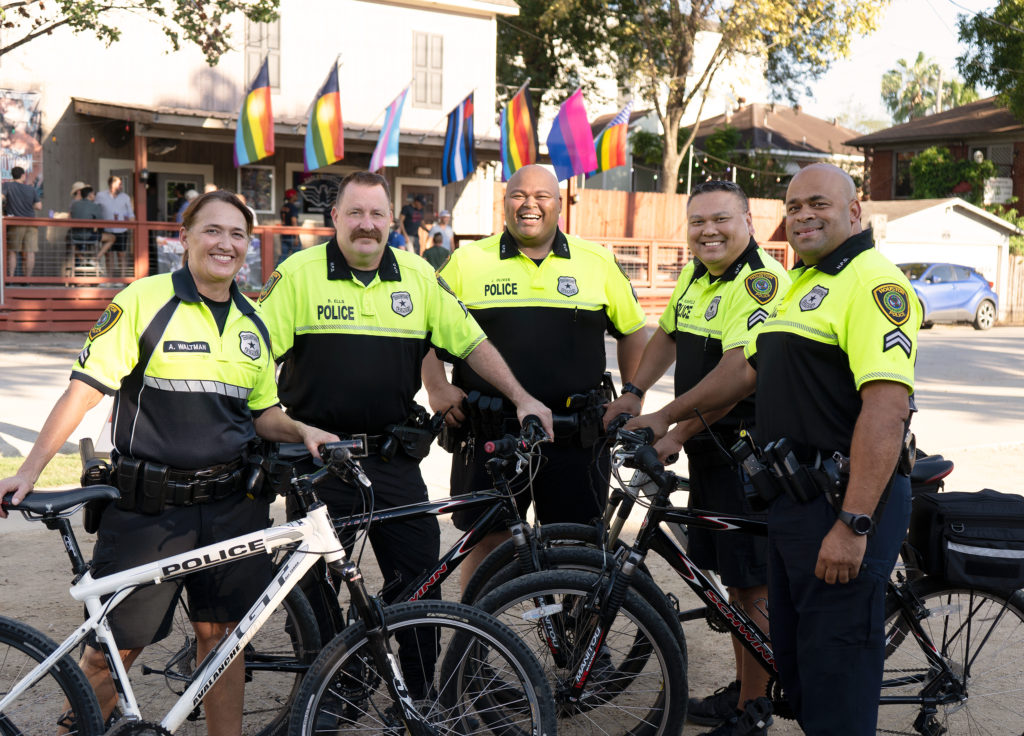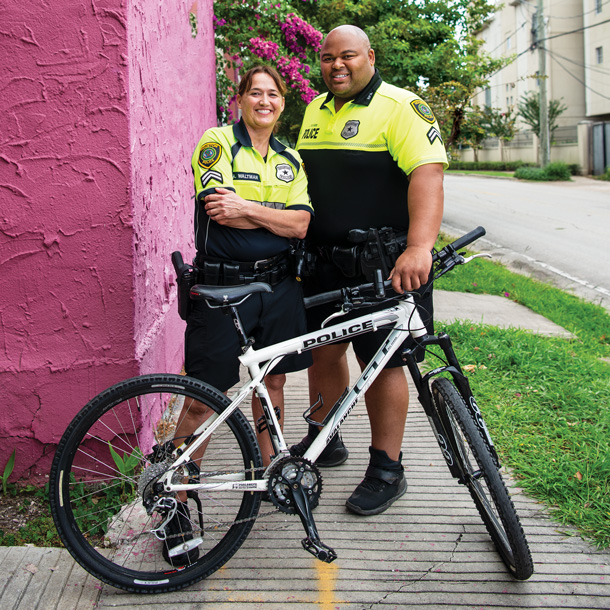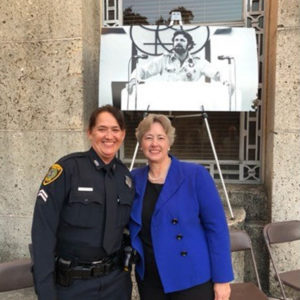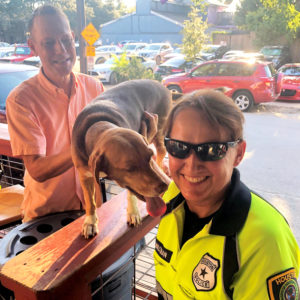
COVER STORY: Keeping the Club Zone Safe
Montrose bicycle cops celebrate 10 years of patrolling the gayborhood.

They are a familiar sight to Montrose club-goers—police on bikes with their neon-yellow shirts. Lawbreakers fear them because they are so effective, but Houston’s LGBTQ community feels great admiration and affection for them.
This Houston Police Department (HPD) security operation is now in its tenth year of patrols in the Houston gayborhood. It is coordinated by out HPD senior police officer Ann Waltman, who formed the squad in 2009.
Houston Police Chief Art Acevedo notes that the bike group has brought his officers closer to the community they serve. “By being accessible and visible, [they] enhance the safety and security of people in the Montrose area. It’s definitely something worth celebrating.”
Collaborating against Crime
The group has no official name, but its members are commonly referred to as the Montrose bicycle cops. They are an approved off-duty HPD activity, and the officers dress in their HPD bike-cop uniforms—neon-yellow shirts and black shorts.
“By being accessible and visible, [they] enhance the safety and security of people in the Montrose area. It’s definitely something worth celebrating.”
Their salaries are paid by a collective comprised of Eagle Houston, George Country Sports Bar, Numbers Disco, and the Hollywood business strip. Two officers patrol together, Thursday through Sunday each week for four hours during the clubs’ busiest times. During special events like Halloween and New Year’s, four officers are assigned.
Currently, Waltman is assisted by six HPD officers: senior police officers Brian Ells, Ted Adams, Jeffrey Oliver, Adam Bushfield, Tony Ramos, and Sgt. Kathleen Wingfield. Waltman and Oliver are out HPD officers, and the others are LGBTQ allies.
Oliver finished the HPD bike school in 2004, and joined the Montrose bike group about a year after it was first organized. Oliver had been assigned to an HPD tactical unit in the Fondren area at the time.
Oliver likes bicycles, because it’s easier to interact with people and to catch illegal activity. “People don’t expect you to be on a bike, and they all have the same foolish look when they are caught,” he says.
HPD is a very accepting workplace for out officers, according to Oliver. He is the sergeant-at-arms for the new HPD LGBTQ committee.
Waltman was recently elected vice president of that committee, which was formed at the request of HPD Chief Acevedo. “We want to send a message to the greater community that we want to be a safe space for all segments of this city, including the LGBT community,” Acevedo says. “I am proud that officer Waltman and other members of the department have started the association. They took the challenge from the chief and are making it happen!”
Oliver says he enjoys interacting with all different types of LGBTQ people as he works the Montrose club area. “People who know us will come up to us and talk about things that they wouldn’t ordinarily talk with a police officer about,” he says. They often approach Oliver just to express their appreciation for what he does.
All of the Montrose patrol officers, who must be “bike certified,” earn their certification by attending the department’s bike school and passing a physical-endurance exam. They learn how to patrol and what to do when engaging with criminals. The school also focuses on dealing with a variety of obstacles. “We get our share of bruises!” says Waltman.

The officers patrol the areas between the clubs that sponsor them, watching for criminal activity such as auto theft, armed robbery, assaults, and illegal drug sales. The clubs in the collective have a special phone number for the flip-phone that the officers carry in case help is needed inside a club—mostly rowdy patrons or heavily intoxicated customers who try to drive home.
Waltman says that most intoxicated suspects are given the option of calling an Uber or Lyft. If they refuse, they are arrested and a police wagon is called to take them to a special sober-up facility at the downtown jail. When arrests are made for more serious charges, they are booked into the jail—where the officer must spend almost two hours filling out the paperwork for one arrest.
The officers also help club owners by tracking down people who try to walk out on their bar tabs. “We once chased two suspects across Montrose Boulevard before we caught up with them,” Waltman says.
Currently, the officers average about four to five arrests a week, ranging from auto theft to disorderly conduct.
Drugs are a major concern for the officers. The current drugs of choice are bath salts, Kush, and PCP. “Bath salts make people want to take their clothes off, PCP makes them superhuman, and Kush is synthetic marijuana—no one knows exactly what is put into it,” Waltman says.
Halloween is Waltman’s favorite night of the year. “The costume contests at Eagle and Numbers are amazing,” she says. But the night also presents challenges to public-decency laws—females cannot expose their nipples and neither sex can display their genitals. Waltman has stopped many a gay man from wearing a G-string or cock sock. She tells them, “Nope, this isn’t going to happen!” She has found that men usually have an extra set of briefs with them to change into.
Mark DeLange, owner of Eagle Houston, says the bike patrol is a vital service that benefits everyone who comes into the neighborhood at night to have fun. “Even though we as a community are more accepted—something we’ve always wanted—I’m still reminded of the Paul Broussard and Pulse tragedies. [Providing security] is an important part of our commitment to a community that we not only serve, but live and work in also!”
A Decade of Improvements
Waltman started the bicycle patrol in November 2009 after watching HPD crime statistics and seeing that crime in the Montrose club area was soaring. She noticed that most of the apprehended criminals were from zip-codes outside of Montrose, and realized that drug dealers were targeting Montrose because they could get higher prices. Where drugs go, crime follows. In some cases, dealers would sell drugs and then assault the buyer and steal their car.
Club patrons became worried about their safety, getting from their cars to a club, or moving from club to club. The word was out that Montrose wasn’t safe, and clubs were seeing a dip in their sales. Patrolling the Montrose area was Waltman’s regular HPD beat, and she was worried about her community. She felt deeply that something needed to change.
“Even though we as a community are more accepted, [providing security] is an important part of our commitment to a community that we not only serve, but live and work in also!”—Mark DeLange, Eagle Houston
Waltman spent three months organizing a meeting of several bar owners. She asked them to fund a bicycle patrol collectively, and explained that it would be a win/win situation for them—the level of crime would drop, and business would increase again. The bicycle officers are also cheaper than HPD cruiser patrols because there is no gas or vehicle maintenance expense, and they can maneuver around traffic to respond to calls more quickly.
In the first year of operation, the bike cops made 378 arrests. The first two years of the patrol were the hardest, but finally the crime level dropped. Club owners and patrons were all pleased with the results. Waltman continues to monitor Montrose crime statistics, and notices that crime outside the patrol area is always higher than within its boundaries.
In the past decade, several different HPD officers have come and gone from the patrol group. Waltman doesn’t have a large pool to recruit from, since the bike cops must be HPD officers who are bike-certified.
Uniforms have changed since the patrol started. HPD bicycle officers used to wear the regular HPD uniforms, but four years ago the neon-yellow uniforms were introduced as a safety measure. Waltman says, “The new uniforms are safer for the officers, but it’s harder to sneak up on criminals.”
A 30-Year Police Career
Waltman joined the HPD in 1989 and began patrolling in 1990. In 1998, she went through the bike school and received her certification. In 2000, Waltman asked to be assigned to the Montrose area, and has been working the neighborhood as her regular beat for 19 years.
Waltman was born in Beaumont in 1966 and moved to Houston when she was five. She enjoyed playing softball and soccer in elementary and middle school, and was part of a high school team that won a district championship. Waltman remembers watching Policewoman, Cagney & Lacey, and The Bionic Woman. Her first love, though, was Lynda Carter in Wonder Woman.

From the age of 17, Waltman wanted to be a police officer. When she heard an HPD recruiting commercial on KILT radio, “It was like flipping on a light switch, and the bulb has never gone off,” she says. But when she reached the hiring age of 19, HPD changed it to 21—and then went into a two-year hiring freeze. Walton joined the Army Reserves instead, and studied criminology at UH Downtown where she earned a bachelor’s degree in 1996. In 2005, she earned a master’s degree from UH Clear Lake.
When Waltman was finally able to apply to HPD in 1989, she went up against over 1,000 applicants. She was chosen for a class of 70, which included seven women. The first time she put on a uniform, she felt that she was “born to it.”
At 53, Waltman looks younger than her age, in spite of the scars that show her dedication to her career. In the past three decades, she has had nine surgeries from assaults occurring on the job. She says, “One has to accept reality. If you can’t handle the danger, you shouldn’t be a police officer.” Recently, Waltman requested reassignment to the Memorial Park beat. “I want to start winding down for retirement,” she says.
Waltman is a familiar face in Houston’s LGBTQ community. In 2001, she was among the first out HPD officers to march in the Pride parade, and she’s marched in nearly every parade since. She has also worked on the security team at Bunnies on the Bayou for the past 18 years. When Houston’s pioneering LGBTQ activist Ray Hill was terminally ill in late 2018, Waltman visited him three or four times every week. Hill chose her to be one of his honorary pallbearers.
Since 2000, Waltman has coordinated security for the annual Pride festival and the street closures for the parade staging area. HPD supplies nearly 500 officers for the parade, but Pride Houston is responsible for festival security. In 2019, Waltman managed 144 off-duty officers who provided security throughout the day.
Looking back, Waltman says that when she first applied to HPD, she had to remain in the closet, but things have changed dramatically within HPD since then. Reflecting on her career, she says she loves her job because “every day is different, and no two days are the same.” She also enjoys meeting so many different types of people.
A Caring Community

Managing the Montrose bike patrol is not about the money, Waltman says. It’s about all of the people who come up to her and thank her for being out there. “Sometimes people have tears in their eyes,” she says. “That’s why I’m still here!” She loves her community, and they love her back.
Waltman says she enjoys a lot of things about the Montrose club zone, such as a group that brings their pets to Eagle’s front porch area every Sunday afternoon. She smiles when she thinks about two people who use the Numbers parking lot every Friday night to practice their whipping skills, using beer cans for target practice. “You can hear those whips cracking three blocks away!”
The thing that touches Waltman the most, however, is the free Thanksgiving dinners that many of the clubs offer to the community. “For so many LGBT people, gay clubs have been the only place where they’ve felt a sense of family, and on this special day the clubs give them a family to celebrate with.”
This article appears in the November 2019 edition of OutSmart magazine.











FB Comments